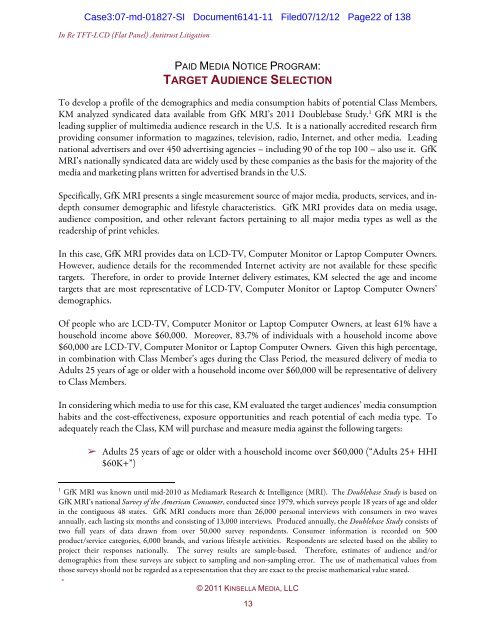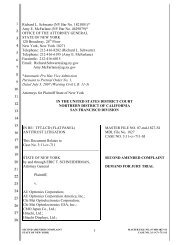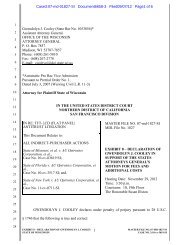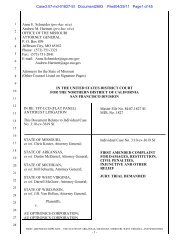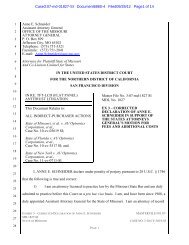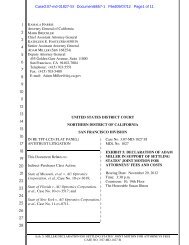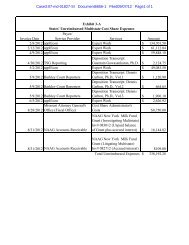UNITED STATES DISTRICT COURT FOR THE ... - LCD Class Action
UNITED STATES DISTRICT COURT FOR THE ... - LCD Class Action
UNITED STATES DISTRICT COURT FOR THE ... - LCD Class Action
You also want an ePaper? Increase the reach of your titles
YUMPU automatically turns print PDFs into web optimized ePapers that Google loves.
Case3:07-md-01827-SI Document6141-11 Filed07/12/12 Page22 of 138<br />
In Re TFT-<strong>LCD</strong> (Flat Panel) Antitrust Litigation<br />
PAID MEDIA NOTICE PROGRAM:<br />
TARGET AUDIENCE SELECTION<br />
To develop a profile of the demographics and media consumption habits of potential <strong>Class</strong> Members,<br />
KM analyzed syndicated data available from GfK MRI’s 2011 Doublebase Study. 1 GfK MRI is the<br />
leading supplier of multimedia audience research in the U.S. It is a nationally accredited research firm<br />
providing consumer information to magazines, television, radio, Internet, and other media. Leading<br />
national advertisers and over 450 advertising agencies – including 90 of the top 100 – also use it. GfK<br />
MRI’s nationally syndicated data are widely used by these companies as the basis for the majority of the<br />
media and marketing plans written for advertised brands in the U.S.<br />
Specifically, GfK MRI presents a single measurement source of major media, products, services, and indepth<br />
consumer demographic and lifestyle characteristics. GfK MRI provides data on media usage,<br />
audience composition, and other relevant factors pertaining to all major media types as well as the<br />
readership of print vehicles.<br />
In this case, GfK MRI provides data on <strong>LCD</strong>-TV, Computer Monitor or Laptop Computer Owners.<br />
However, audience details for the recommended Internet activity are not available for these specific<br />
targets. Therefore, in order to provide Internet delivery estimates, KM selected the age and income<br />
targets that are most representative of <strong>LCD</strong>-TV, Computer Monitor or Laptop Computer Owners’<br />
demographics.<br />
Of people who are <strong>LCD</strong>-TV, Computer Monitor or Laptop Computer Owners, at least 61% have a<br />
household income above $60,000. Moreover, 83.7% of individuals with a household income above<br />
$60,000 are <strong>LCD</strong>-TV, Computer Monitor or Laptop Computer Owners. Given this high percentage,<br />
in combination with <strong>Class</strong> Member’s ages during the <strong>Class</strong> Period, the measured delivery of media to<br />
Adults 25 years of age or older with a household income over $60,000 will be representative of delivery<br />
to <strong>Class</strong> Members.<br />
In considering which media to use for this case, KM evaluated the target audiences’ media consumption<br />
habits and the cost-effectiveness, exposure opportunities and reach potential of each media type. To<br />
adequately reach the <strong>Class</strong>, KM will purchase and measure media against the following targets:<br />
➢ Adults 25 years of age or older with a household income over $60,000 (“Adults 25+ HHI<br />
$60K+”)<br />
1 GfK MRI was known until mid-2010 as Mediamark Research & Intelligence (MRI). The Doublebase Study is based on<br />
GfK MRI’s national Survey of the American Consumer, conducted since 1979, which surveys people 18 years of age and older<br />
in the contiguous 48 states. GfK MRI conducts more than 26,000 personal interviews with consumers in two waves<br />
annually, each lasting six months and consisting of 13,000 interviews. Produced annually, the Doublebase Study consists of<br />
two full years of data drawn from over 50,000 survey respondents. Consumer information is recorded on 500<br />
product/service categories, 6,000 brands, and various lifestyle activities. Respondents are selected based on the ability to<br />
project their responses nationally. The survey results are sample-based. Therefore, estimates of audience and/or<br />
demographics from these surveys are subject to sampling and non-sampling error. The use of mathematical values from<br />
those surveys should not be regarded as a representation that they are exact to the precise mathematical value stated.<br />
© 2011 KINSELLA MEDIA, LLC<br />
13


